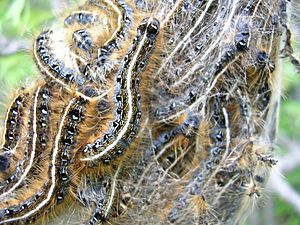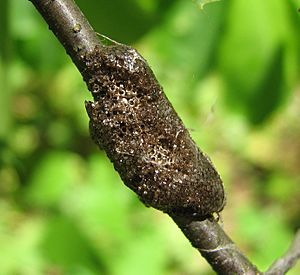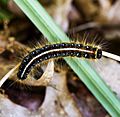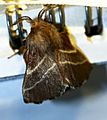Eastern tent caterpillar facts for kids
Quick facts for kids Eastern tent caterpillar |
|
|---|---|
 |
|
| Caterpillar | |
| Scientific classification | |
| Synonyms | |
|
The eastern tent caterpillar (Malacosoma americanum) is a type of moth. It belongs to the family Lasiocampidae, which includes other tent caterpillars. These moths have one generation each year.
Eastern tent caterpillars are known for being very social. They build large, shared nests, called "tents," in tree branches. Sometimes, people confuse them with other caterpillars like the gypsy moth or the fall webworm. They are also sometimes mistakenly called bagworms, which are different insects.
These moths usually lay their eggs on trees in the Rosaceae plant family. This includes cherry (Prunus) and apple (Malus) trees. The caterpillars are hairy and have patches of blue, white, black, and orange. The blue and white colors are special. They are "structural colors," meaning they come from how light bounces off tiny structures on the caterpillar's skin.
Contents
What Makes Eastern Tent Caterpillars Social?
Tent caterpillars are some of the most social larvae (young insects) you can find.
Life Cycle of the Eastern Tent Caterpillar
The adult female moth lays all her eggs in one batch. This usually happens in late spring or early summer. Each egg mass holds about 200 to 300 eggs.
Inside the eggs, tiny caterpillars form quickly, in about three weeks. These small caterpillars then stay still until the next spring. They hatch out of their eggs just as the tree buds start to open.
Building and Living in the Tent
Soon after hatching, the new caterpillars start building their silk tent. They usually stay together at the tent site throughout their caterpillar stage. They make the tent bigger every day as they grow.
In nature, these caterpillars eat three times a day:
- Just before sunrise
- In the middle of the afternoon
- After sunset
During each feeding time, the caterpillars leave the tent. They add more silk to the tent, then move together to find food. After eating, they go right back to the tent to rest. The only time this changes is in their last stage of growth. Then, they only feed at night.
A caterpillar goes through six growth stages, called instars. In the last stage, the caterpillars leave the tent and each builds its own cocoon in a safe spot. About two weeks later, the adult moths come out of their cocoons.
Adult Moths and Reproduction
Adult moths are active only at night. They start flying after dark and usually settle down a few hours before sunrise. Mating and egg-laying often happen on the same day the moths emerge. The female moths usually die soon after laying their eggs.
How Caterpillars Protect Themselves
Tent caterpillars, like many social caterpillars, have a cool way to scare off enemies. When they sense predators (animals that hunt them) or parasitoids (insects that lay eggs on or in them), they shake the front part of their bodies very fast.
One caterpillar can start this shaking, and it quickly spreads through the whole group. Dozens of caterpillars might join in. This group display makes it hard for small insects like tachinid flies or wasps to lay eggs on them. It also scares away shy predators like stink bugs.
When many caterpillars rest on the tent's surface, it acts as a warning sign. Their bright colors and group display tell predators to stay away. Most birds don't like to eat these hairy caterpillars, except for cuckoos. Also, cherry leaves contain a substance that can become cyanide. When disturbed, the caterpillars can regurgitate (spit up) juices that contain this substance.
Tents and Temperature Control
The eastern tent caterpillar builds one of the largest tents among all tent caterpillars. They usually build it in the fork of a tree branch. The widest part of the tent often faces southeast to catch the morning sun.
How the Tent is Built
The caterpillars add silk to the tent's surface at the start of each daily activity period. They lay down the silk a little tightly. This causes the new silk layer to pull away from the layer below it. So, the tent has several layers with spaces in between where the caterpillars rest.
The tent has openings for the caterpillars to go in and out. These openings are often where branches stick out, but they are most common at the top of the tent.
Light affects how the caterpillars spin silk. They spin most of their silk on the side of the tent that gets the most light. If the main light source comes from below, they will even build their tent upside down!
Caterpillars keep making their tent bigger until they reach their last stage of growth. At this point, they save their silk for building their cocoons and stop adding to the tent.
Why the Tent is Important
The tents serve many purposes:
- They help the caterpillars warm up in the sun.
- They offer some protection from enemies.
- They provide safe places to rest.
- They act as a meeting point before the caterpillars go out to feed together.
- The higher humidity inside the tent might help them when they are molting (shedding their skin).
Staying Warm in Early Spring
Eastern tent caterpillars are some of the first caterpillars to appear in spring. The weather can still be cold then. So, the caterpillars need the sun's heat to warm their bodies. This helps them digest their food. Studies show that below 15°C (59°F), they can't process food well.
Young caterpillars are black, which helps them absorb heat easily. When they are warming up, they often huddle together tightly. This reduces heat loss from air currents. Their long hairs also help keep them warm.
Caterpillars can gather on the tent's surface or inside it. The tents work like tiny greenhouses. They trap the morning sun's heat, allowing the caterpillars to warm up faster. A group of caterpillars basking can reach temperatures much higher than the air around them. They can get too hot, so they spread out when they reach a good temperature.
Because the tent has layers, different parts of it have different temperatures. Caterpillars can move between layers to control their body temperature. They can also gather on the shaded side of the tent and hang by their abdomens to cool down.
Eastern tent caterpillars can also create a small amount of heat from their own bodies when they digest food. When recently fed caterpillars pack together, the temperature inside the group can be a few degrees warmer than the air, even without sunlight. It's not clear how much this small heat helps them grow.
How Caterpillars Find Food
Tent caterpillars leave a silk trail wherever they go. Often-used paths soon have clear silk trails. As they move around the tree, they mostly stick to these trails. They also leave special scents, called pheromones, along the trails by dragging their bodies.
When caterpillars find food, they can "overmark" the trails they use to go back to the tent. This creates "recruitment trails." These trails are much more attractive to other caterpillars than regular exploration trails. They help lead the whole group directly to the new food source. Just one caterpillar finding food can bring the entire colony to it.
Scientists haven't fully identified the exact chemical that makes up the trail pheromone. However, a chemical called 5β-cholestane-3-one has been shown to work just like it. Caterpillars will readily follow trails made with this chemical, even leaving their own trails for it.
Are Eastern Tent Caterpillars Pests?
The eastern tent caterpillar is sometimes seen as a pest. This is because they can eat all the leaves off ornamental trees. However, the damaged trees usually grow new leaves within a few weeks.
Toxicity
Eastern tent caterpillars can be harmful to horses if eaten.
Images for kids








